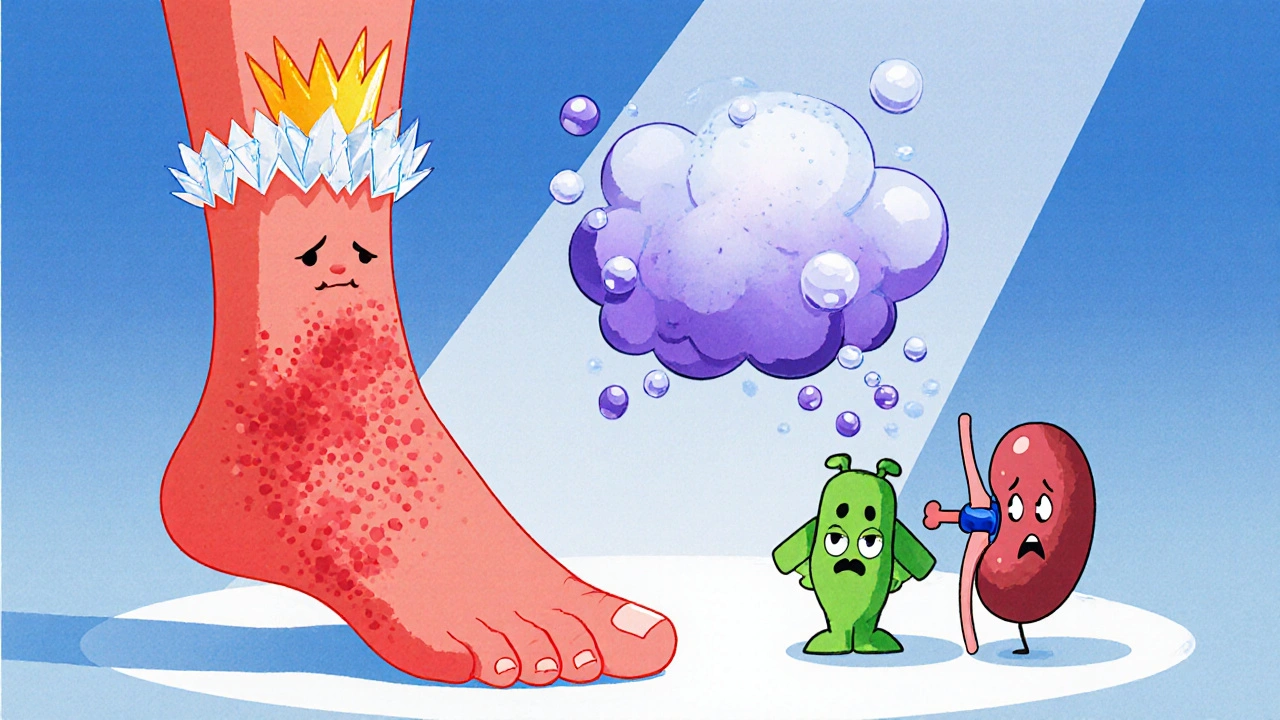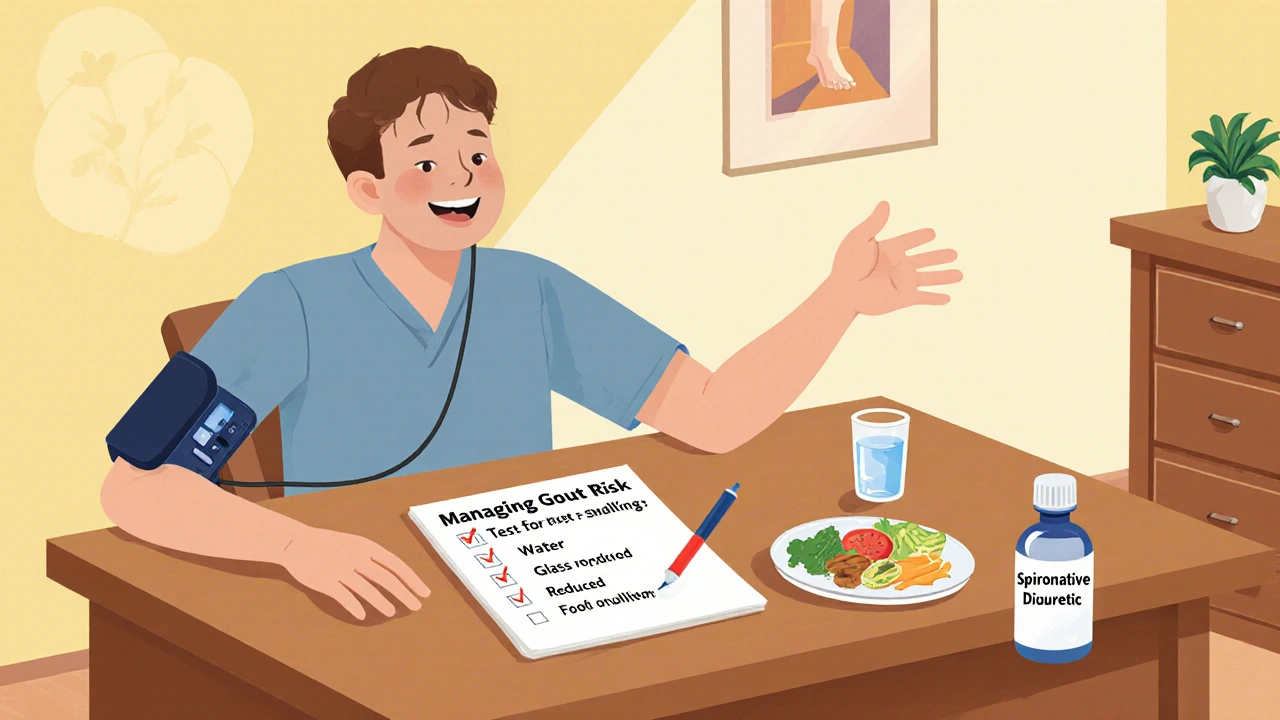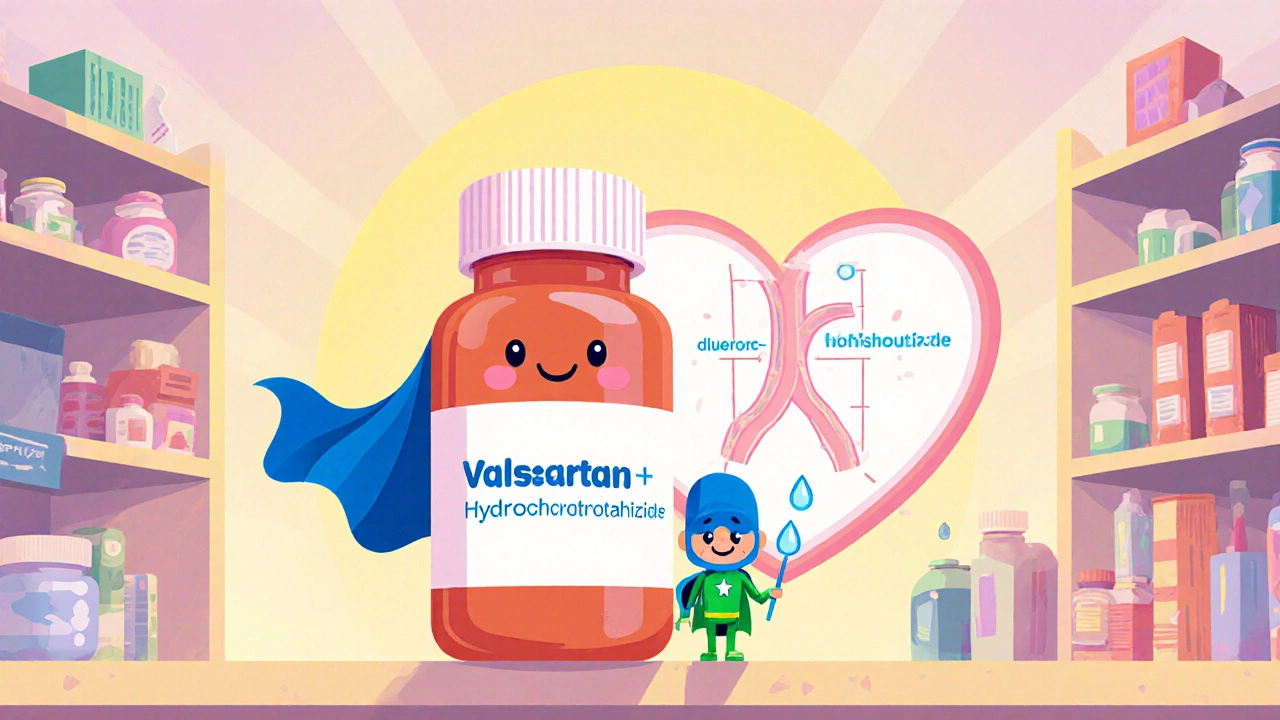Uric Acid Risk Calculator
Calculate Your Gout Risk
This tool estimates your risk of developing gout when taking valsartan-hydrochlorothiazide based on your current uric acid level. The thiazide component can raise uric acid by 0.5-0.8 mg/dL.
When you pick up a prescription for a blood‑pressure pill, you probably focus on the numbers it will lower. But what if that pill also nudges another health issue - gout? This article unpacks the science behind valsartan hydrochlorothiazide gout concerns, showing you when the combo might matter and how to stay ahead of a painful flare.
What is Valsartan-Hydrochlorothiazide?
Valsartan-Hydrochlorothiazide is a fixed‑dose combination medication that merges valsartan, an angiotensin II receptor blocker (ARB), with hydrochlorothiazide, a thiazide‑type diuretic. The blend targets hypertension and, in some regions, heart‑failure management. By pairing an ARB with a diuretic, doctors can achieve better blood‑pressure control while potentially reducing the pill burden for patients.
How does the combo work?
Valsartan blocks the angiotensin II receptor, preventing the hormone from tightening blood vessels. The result is relaxed arteries and lower blood‑pressure readings. Hydrochlorothiazide, on the other hand, promotes sodium and water excretion via the kidneys, decreasing blood‑volume. Together, they attack two major drivers of high pressure: vascular tone and fluid overload.
Known side effects of Valsartan-Hydrochlorothiazide
Both components bring their own safety profile. Common ARB‑related issues include dizziness, headache, and elevated potassium levels. Thiazide diuretics are notorious for raising serum uric acid, causing low potassium, and increasing blood‑sugar. When mixed, the side‑effect spectrum can overlap, so clinicians keep an eye on kidney function, electrolytes, and, importantly, uric‑acid trends.
Understanding gout
Gout is a form of inflammatory arthritis triggered by the deposition of monosodium urate crystals in joints. The culprit is usually elevated serum uric acid, which can result from either overproduction or reduced renal excretion. Classic gout attacks strike the big toe, but they can affect any joint, producing sudden, excruciating pain, swelling, and redness.

Is there a pharmacological link?
Thiazide diuretics, including hydrochlorothiazide, reduce the kidney’s ability to clear uric acid. The mechanism involves increased reabsorption of urate in the proximal tubule, partly due to volume depletion and competition for organic‑anion transporters. While valsartan alone is generally neutral-or even slightly urate‑lowering-in some studies, the diuretic component can tip the balance toward hyperuricemia.
Evidence from clinical studies
Multiple epidemiologic analyses have linked thiazide use to higher gout incidence. A 2020 cohort of over 250,000 US veterans showed a 30% rise in gout diagnoses among thiazide users versus non‑users after adjusting for age, BMI, and kidney function. When the same group examined fixed‑dose ARB‑thiazide combos, the odds ratio hovered around 1.25, indicating a modest but real increase.
Randomised controlled trials (RCTs) of valsartan‑hydrochlorothiazide rarely list gout as a primary endpoint, but they do report mean serum uric‑acid rises of 0.5-0.8 mg/dL after six months of therapy. For patients whose baseline uric acid sits near the gout threshold (≈6.8 mg/dL), that uptick can push them over the edge.
Who is at higher risk?
- Uric Acid levels already in the upper‑normal range.
- Pre‑existing gout or a history of gout flares.
- Renal impairment that limits uric‑acid excretion.
- Concurrent use of other urate‑raising drugs (e.g., low‑dose aspirin, cyclosporine).
- Metabolic syndrome components - obesity, high triglycerides, insulin resistance.

Managing the risk
If you’re prescribed valsartan‑hydrochlorothiazide and have any of the above risk factors, discuss a monitoring plan with your clinician. Here’s a practical checklist:
- Baseline labs: serum uric acid, creatinine, electrolytes, fasting glucose.
- Re‑check uric acid at 1‑month and 3‑month intervals.
- If uric acid rises >0.5 mg/dL or symptoms appear, consider switching the thiazide component to a potassium‑sparing diuretic (e.g., spironolactone) or an alternative ARB‑only regimen.
- Dietary tweaks: reduce purine‑rich foods (red meat, seafood), limit alcohol (especially beer), stay hydrated.
- When needed, add a urate‑lowering therapy such as allopurinol or febuxostat. Allopurinol is the most commonly used first‑line agent with a well‑known safety profile.
Key takeaways
- The ARB part of valsartan‑hydrochlorothiazide does not increase gout risk; the thiazide part can.
- Patients with borderline uric‑acid levels are the most vulnerable.
- Regular lab monitoring and lifestyle adjustments can blunt the risk.
- Switching to a non‑thiazide diuretic or adding a urate‑lowering drug are viable strategies if gout emerges.
Frequently Asked Questions
Can valsartan‑hydrochlorothiazide cause my first gout attack?
Yes, especially if your baseline uric‑acid level is already near the gout threshold. The thiazide component can raise serum uric acid enough to trigger a first flare.
Do all thiazide diuretics increase gout risk equally?
The risk is dose‑related. Higher doses of hydrochlorothiazide tend to lift uric acid more than low‑dose formulations. Some newer thiazide‑like diuretics (e.g., indapamide) appear to have a milder effect.
Should I stop taking my blood‑pressure pill if I develop gout?
Never stop a prescription on your own. Talk to your doctor about switching to a non‑thiazide regimen or adding a urate‑lowering medication.
How often should uric‑acid levels be checked while on this combo?
A sensible schedule is baseline, 1 month, and then every 3 months, or sooner if you notice joint pain.
Are there any alternatives to hydrochlorothiazide that don’t raise uric acid?
Yes. Potassium‑sparing diuretics (spironolactone, eplerenone) or calcium‑channel blockers can control blood pressure without significantly affecting uric acid.
Risk‑Comparison Table
| Parameter | Valsartan‑Hydrochlorothiazide | Valsartan‑Only or Alternative |
|---|---|---|
| Mean ↑ Serum Uric Acid (mg/dL) | 0.5-0.8 | 0.0-0.2 |
| Incidence of New‑Onset Gout (per 1,000 yr) | 12 - 15 | 6 - 8 |
| Electrolyte Disturbance (K⁺ ↓) | Moderate | Low |
| Blood‑Pressure Reduction (mmHg) | ‑12/‑7 | ‑10/‑6 |
Bottom line: the combo gives a slightly stronger pressure drop, but it also nudges uric acid upward more than an ARB‑only strategy. For most patients, the trade‑off is acceptable, yet those with gout history should weigh alternatives.


Comments
Dan Danuts
Great rundown! I appreciate how you broke down the dual action of valsartan‑hydrochlorothiazide and the gout risk. For anyone juggling blood‑pressure meds and a history of gout, keeping an eye on uric‑acid numbers is a smart move. A quick tip: staying well‑hydrated can really help flush excess urate. Keep the info coming – it’s exactly what the community needs.
October 23, 2025 at 20:10
Dante Russello
What a comprehensive piece-thanks for the depth!; the tables give a clear visual, and the bullet points hit the key risk factors spot‑on. I especially like the recommendation to re‑check uric‑acid at one‑month and three‑month intervals; it gives clinicians a practical roadmap. This kind of balanced, data‑driven guidance makes managing hypertension far less daunting. Keep up the solid work!
October 28, 2025 at 20:10
James Gray
Yo, love the vibe! I think uric‑acid monitoring is super easy if you set reminders on your phone – no big deal. Even if you’re on the combo, a bit of diet tweaking can keep the gout monster at bay. Plus, many folks never get a gout flare once they switch to a potassium‑sparing diuretic. Stay positive, bro!
November 2, 2025 at 20:10
Scott Ring
Thanks for the thorough analysis – truly helpful. While the data is solid, I’d add that individual response can vary, especially with renal function nuances. It’s wise to discuss alternative diuretics with a provider when borderline uric‑acid levels appear. That balanced approach respects both efficacy and safety. Appreciate the clarity.
November 7, 2025 at 20:10
Shubhi Sahni
Excellent article!!! The way you outlined the mechanism behind thiazide‑induced hyperuricemia is crystal clear!!! I also appreciate the practical checklist – it’s a gold‑standard guide for both patients and clinicians!!! Monitoring labs at baseline, one month, and then quarterly is a smart protocol!!! Well done!!!
November 12, 2025 at 20:10
Danielle St. Marie
While the checklist is decent, it barely scratches the surface of nuanced pharmacology. A true connoisseur knows that not all thiazides are created equal – indapamide, for instance, exerts a milder urate‑raising effect. 🌟 Moreover, embracing personalized medicine supersedes one‑size‑fits‑all protocols. 🙄 If you’re aiming for excellence, consider genetic testing for urate transporters. 🇺🇸💪
November 17, 2025 at 20:10
keerthi yeligay
True point – genetics can guide therapy. Short and sweet.
November 22, 2025 at 20:10
deepak tanwar
Although the article presents a compelling correlation between thiazide diuretics and gout, one must question the causality implied. Numerous observational studies suffer from confounding variables, such as dietary purine intake and concomitant medications, which may inflate the perceived risk. Furthermore, the modest increase in serum uric‑acid (0.5‑0.8 mg/dL) may be clinically insignificant for many patients. It would be prudent to await randomized trials specifically targeting gout outcomes before deeming the combination hazardous.
November 27, 2025 at 20:10
Abhishek Kumar
Seems fine to me.
December 2, 2025 at 20:10
kenny lastimosa
In pondering the interplay of blood‑pressure control and uric‑acid dynamics, one is reminded of the ancient principle of balance – too much force in one direction inevitably produces a countervailing effect. The valsartan‑hydrochlorothiazide duo embodies this duality, delivering potent antihypertensive action while nudging the body toward hyperuricemia. Recognizing such trade‑offs invites a more holistic view of therapy, where numbers on a lab sheet are but one voice among many. Embracing this perspective can lead to more patient‑centered decisions.
December 7, 2025 at 20:10
Write a comment